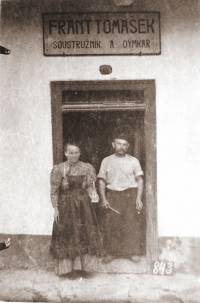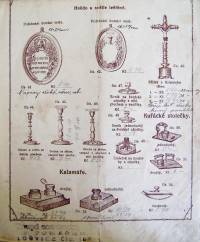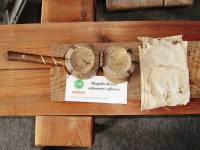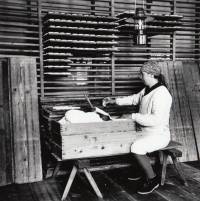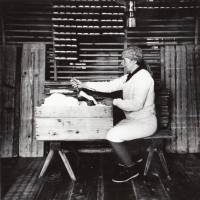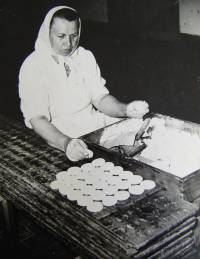The term “mould” is for the first time mentioned in the last years of the 19th century and it is described as „a practical hoop” for the curd cheese. The local craftsmen, mainly wheelers and wood turners, belonged to the mould manufacturers. František Tomášek wood turning plant in Loštice was known for its production of mounds, description of mould production has been preserved till our days.
The hornbeam wood, purchased in Hartínkov u Kladek, was used quite exclusively. For manufacture of one mould, the trunk at least 60 cm long was needed, because drying resulted in cracking of wood block edges and the edges had to be cut off. The blank was cross cut to 4 parts, because the central soft part of the block had to be excluded, as it was unsuitable for turning and machining. The mould was made according to the desired size of the curd cheese and turning was controlled by the „wooden model“. The mould consisted of two rolls connected by the iron hinge (purchased in a store, but a local locksmith R. Mittag had to tinned them before mounting). The bottom roll was fixed on a board, the upper roller was equipped by a wooden handle. Both rollers were turned on the contact area so that - when the inserted curd was pressed - a free space (mould) was created conforming to the requested curd cheese size. The mould was lined by a cheesecloth fixed by nails to prevent curd sticking to the mould and, moreover, when the mould was opened, the future curd cheese was thrown out. The curd cheese producer had to line the mould by the cheesecloth and fix the mould on the board. In case of full capacity service life of one mould was half a year. Besides hornbeams, even less durable materials are documented. The average daily output of one cheese shaper with the mould was 150 threescore, i.e. 9,000 pieces.
The Dairy School in Kroměříž with its curd cheese factory most probably had a high impact on expansion of a new technology, cheese pliers. They had massive wooden handles topped by a pair of opposite-facing perforated cheese-shaped cups lined by textile; the pliers are for the first time mentioned in 1915. The only reference concerning cheese shaping by pliers reports 70 threescore per day. Curd cheese cutters are referred only rarely.
